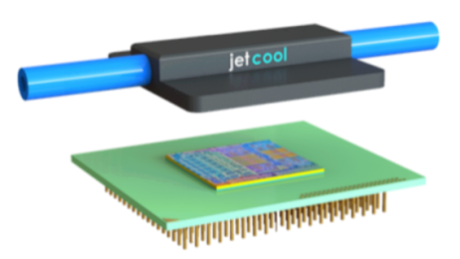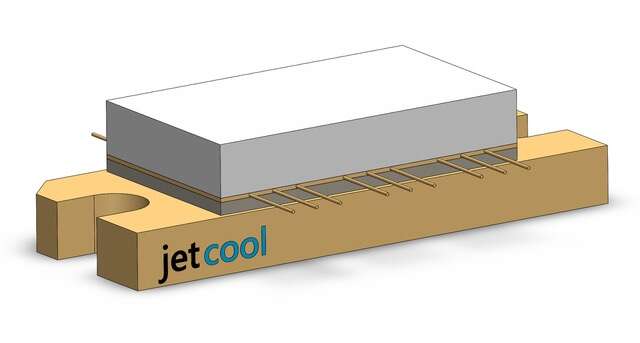Micro-convective Cooling Emerges to Take the Heat
Article By : George Leopold

An MIT spinoff is promoting on-chip micro-convective cooling as a way to beat the heat.
Processing-intensive applications ranging from AI chips and hyperscale datacenters to aerospace applications and all those devices being integrated into electric cars are generating boat-loads of heat. As conventional thermal management techniques fail to keep pace up with all that hot air, an MIT spinoff has come up with a new way to cool electronics.

JetCool’s module for cooling AI processors.
After nearly five years of development, JetCool Technologies recently emerged from stealth mode with an approach it calls micro-convective cooling. The technology uses small fluid jets the company’s CEO said can be integrated into electronic devices.
JetCool CEO Bernie Malouin said the ability to place the fluid jets adjacent to where heat is being generated would yield a ten-fold increase in cooling efficiency compared with the current state of the art. The startup also claims comparable size and weight reductions for aerospace applications.
Micro-convective cooling also is touted as delivering 90 percent of the performance of current cooling technologies since it can be integrated as a heat sink on a silicon substrate without the need for exotic semiconductor materials or complex coding, Maloiun said.
Spun out from MIT in January, JetCool seeks to leverage a $2 million investment in technology development to address growing cooling requirements as datacenters, for example, strain to handle machine learning and other computing-intensive workloads. Malouin also noted the need for better cooling technologies in electric vehicles as more devices are integrated into designs, straining power management systems.
“Those folks are pushing the limits in terms of cooling,” Malouin noted in an interview.
The startup rolled out its micro-convective cooling approach at this year’s International Microwave Symposium in Boston. JetCool was named the event’s “Next Top Startup.”
JetCool is targeting its technology at military and aerospace applications such as power amplifiers and RF components. E-car applications include power inverters and infotainment consoles. It is also geared to wireless applications like optical networking and 5G transmitters.

JetCool’s liquid-cooled flange
for active components such as
aerospace power amps.
The best opportunity to scale the cooling technology appears to be enterprise datacenters that are increasingly powered by graphics processors — often coupled with CPUs — as well as emerging AI chips and ASICs. All are being employed to handle demanding workloads as companies roll out more distributed applications.
Many of those use cases represent a doubling or tripling of power density levels, prompting datacenter operators to look for new ways to dissipate heat generated by racks of servers.
The startup’s approach also reflects expanding research into new ways to cool electronics as heat generation and power dissipation soar. Current thermal management approaches involving remote cooling only work by adding weight and volume to electronic components.
MIT launched its micro-convective cooling effort in 2012. The same year, the Defense Advanced Research Projects Agency initiated a related program called Intrachip/Interchip Enhanced Cooling. Also known as ICECool, the DARPA program explored embedded thermal management techniques, including the integration of microfluidic cooling inside a substrate, chip or package. Among the goals was incorporating new thermal management techniques into the chip design process.